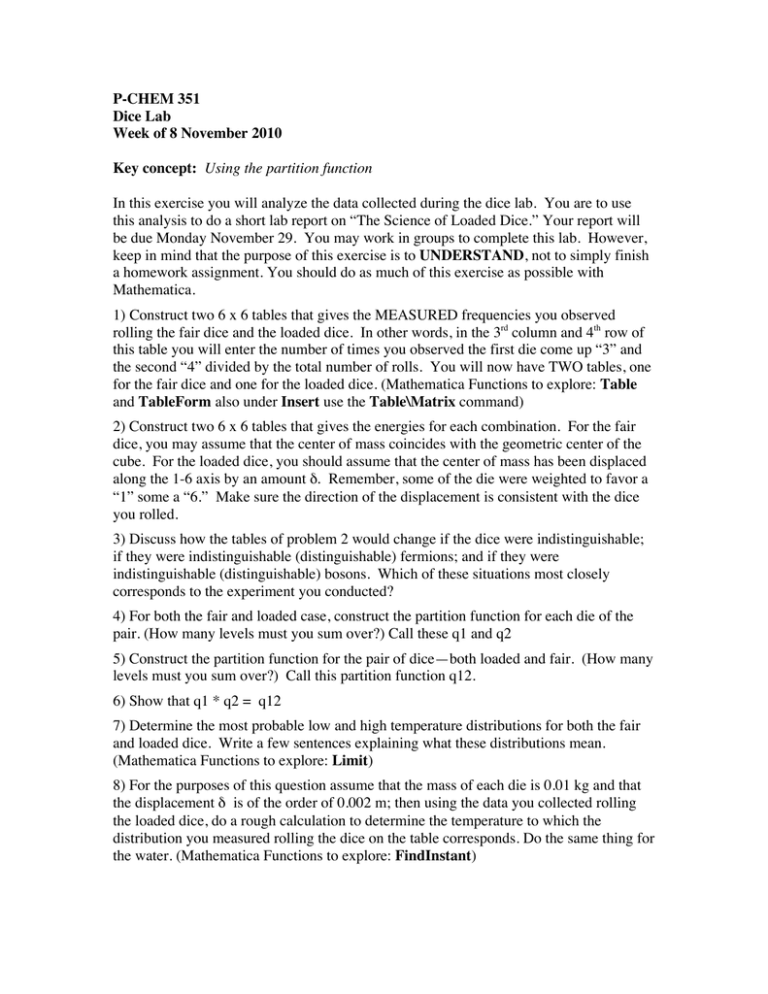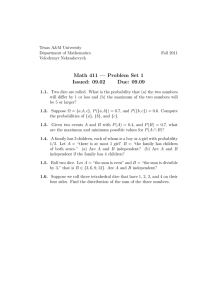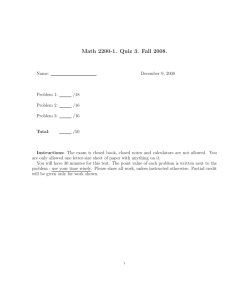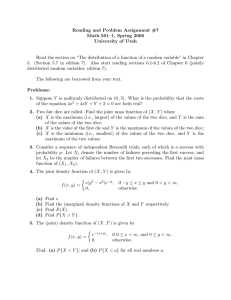P-CHEM 351 Dice Lab Week of 8 November 2010 Key concept:
advertisement

P-CHEM 351 Dice Lab Week of 8 November 2010 Key concept: Using the partition function In this exercise you will analyze the data collected during the dice lab. You are to use this analysis to do a short lab report on “The Science of Loaded Dice.” Your report will be due Monday November 29. You may work in groups to complete this lab. However, keep in mind that the purpose of this exercise is to UNDERSTAND, not to simply finish a homework assignment. You should do as much of this exercise as possible with Mathematica. 1) Construct two 6 x 6 tables that gives the MEASURED frequencies you observed rolling the fair dice and the loaded dice. In other words, in the 3rd column and 4th row of this table you will enter the number of times you observed the first die come up “3” and the second “4” divided by the total number of rolls. You will now have TWO tables, one for the fair dice and one for the loaded dice. (Mathematica Functions to explore: Table and TableForm also under Insert use the Table\Matrix command) 2) Construct two 6 x 6 tables that gives the energies for each combination. For the fair dice, you may assume that the center of mass coincides with the geometric center of the cube. For the loaded dice, you should assume that the center of mass has been displaced along the 1-6 axis by an amount δ. Remember, some of the die were weighted to favor a “1” some a “6.” Make sure the direction of the displacement is consistent with the dice you rolled. 3) Discuss how the tables of problem 2 would change if the dice were indistinguishable; if they were indistinguishable (distinguishable) fermions; and if they were indistinguishable (distinguishable) bosons. Which of these situations most closely corresponds to the experiment you conducted? 4) For both the fair and loaded case, construct the partition function for each die of the pair. (How many levels must you sum over?) Call these q1 and q2 5) Construct the partition function for the pair of dice—both loaded and fair. (How many levels must you sum over?) Call this partition function q12. 6) Show that q1 * q2 = q12 7) Determine the most probable low and high temperature distributions for both the fair and loaded dice. Write a few sentences explaining what these distributions mean. (Mathematica Functions to explore: Limit) 8) For the purposes of this question assume that the mass of each die is 0.01 kg and that the displacement δ is of the order of 0.002 m; then using the data you collected rolling the loaded dice, do a rough calculation to determine the temperature to which the distribution you measured rolling the dice on the table corresponds. Do the same thing for the water. (Mathematica Functions to explore: FindInstant) 9) Using the temperature you calculated in problem 8, compute the thermal energy of the dice (remember this is just kb T). If this energy were all potential, estimate how high a die could be raised with this energy. If the energy were all kinetic, determine how fast a die would be moving with this energy. Use these results to explain the significance of the temperatures calculated in problem 8. Also explain why loaded dice have shaved (rounded) corners.



